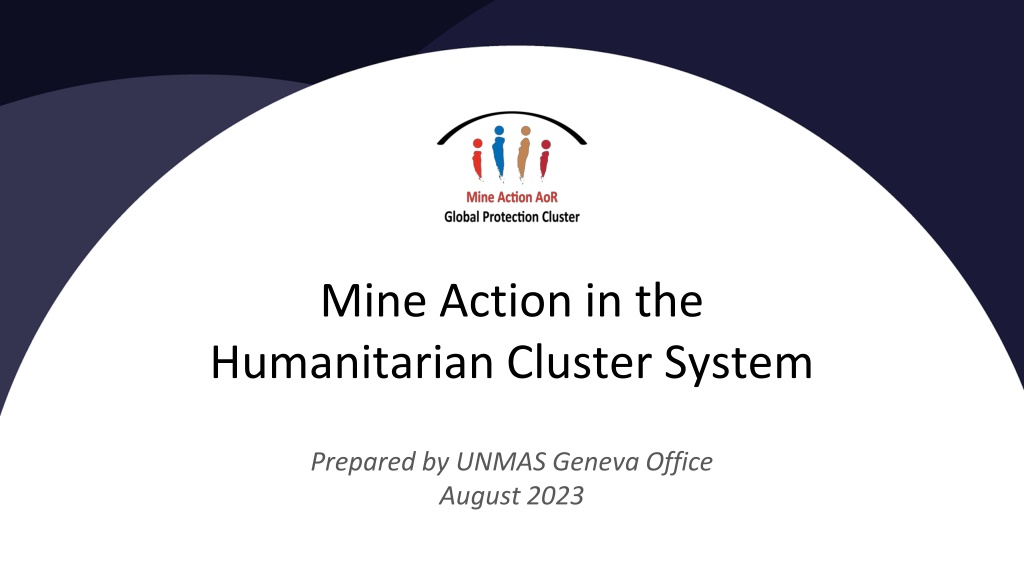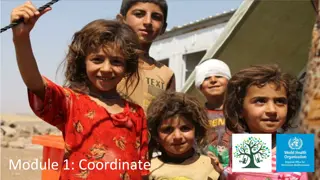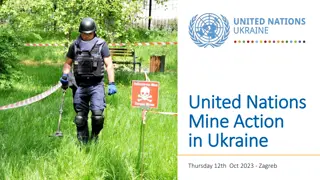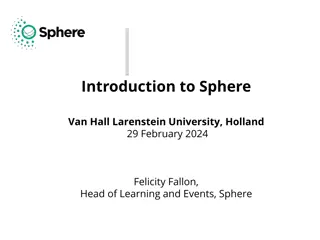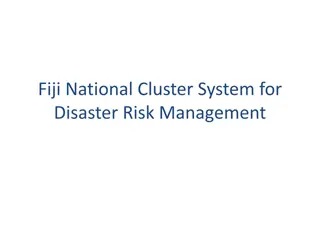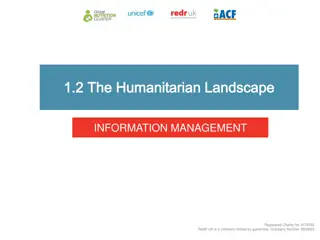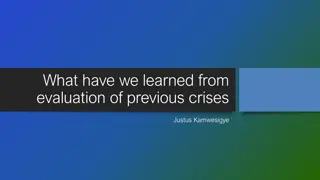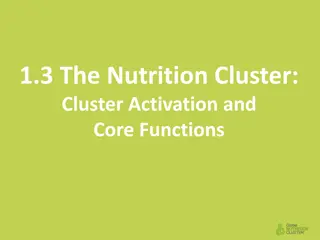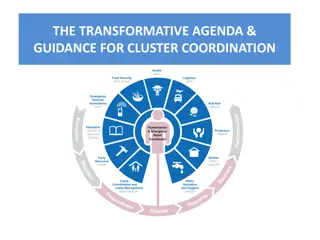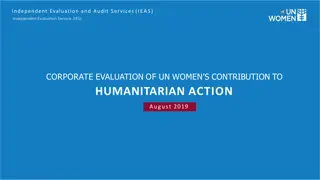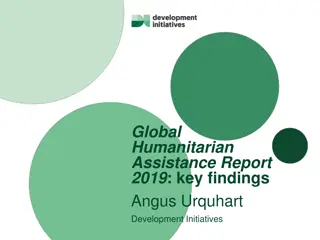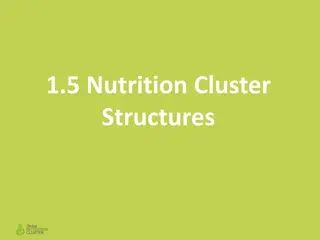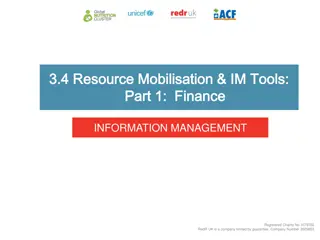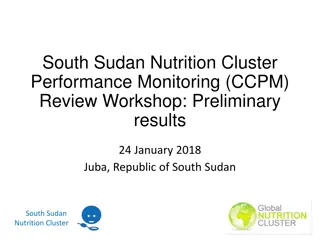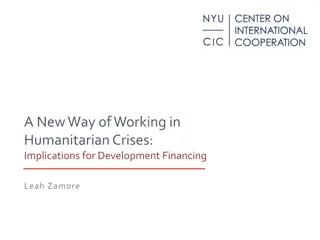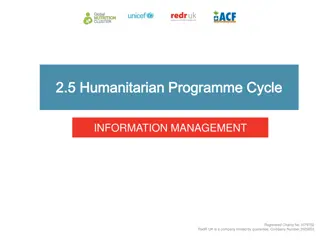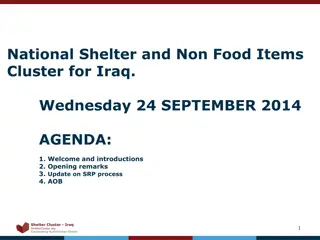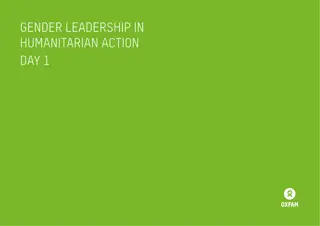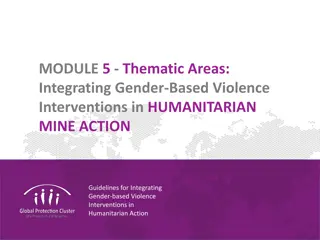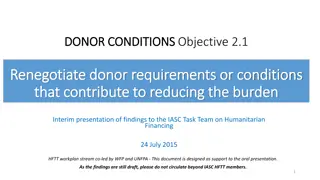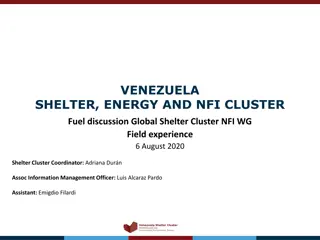Mine Action in the Humanitarian Cluster System
The Inter-Agency Standing Committee (IASC) plays a crucial role in coordinating humanitarian efforts, with a focus on mine action in the global protection cluster. This involves clear responsibilities, strategic planning, and advocacy to address humanitarian needs. The IASC Reference Module for Cluster Coordination outlines key functions and coordination mechanisms for effective cluster management. The six core functions of clusters/AoRs emphasize service delivery, performance evaluation, strategic decision-making support, capacity building, strategy implementation, and advocacy. Additionally, a network of NGOs, IOs, and UN agencies work together to engage in protection work within the humanitarian sector.
Download Presentation

Please find below an Image/Link to download the presentation.
The content on the website is provided AS IS for your information and personal use only. It may not be sold, licensed, or shared on other websites without obtaining consent from the author. Download presentation by click this link. If you encounter any issues during the download, it is possible that the publisher has removed the file from their server.
E N D
Presentation Transcript
Mine Action in the Humanitarian Cluster System Prepared by UNMAS Geneva Office August 2023
Contents 1. Inter-Agency Standing Committee 2. Mine Action in the Humanitarian Cluster System 3. Global Protection Cluster 4. IASC Reference Module for Cluster Coordination 5. Mine Action Area of Responsibility (Functions, Network, Mission, Work, Governance) 6. GPC Strategic Framework 2020-24 7. Members of the MA AoR 8. Humanitarian Needs Overviews and Response Plans 9. MA in HRPs in 2021, 2022, 2023 10. MA AoR Strategy 11. GPC Website: Mine Action AoR
Inter-Agency Standing Committee (IASC) Created by United Nations General Assembly resolution 46/182 in 1991,the Inter-Agency Standing Committee (IASC) is the longest-standing humanitarian coordination forum of the United Nations system. It brings together the executive heads of 18 organizations to formulate policy, set strategic priorities and mobilize resources in response to humanitarian crises. The IASC strengthens collective humanitarian action through the implementation of a coherent, unified response. It advocates for common humanitarian principles and makes strategic, policy and operational decisions with a direct bearing on humanitarian operations on the ground. The IASC is chaired by the Emergency Relief Coordinator (ERC) who brings critical issues to the attention of the United Nations Secretary-General and Security Council. The IASC established the cluster system where agencies have clear responsibilities for coordination of specific sectors. UNHCR leads the Global Protection Cluster (GPC) and UNMAS leads its Mine Action Area of Responsibility.
IASC Reference Module for Cluster Coordination Cluster and Sector Coordination Cluster Activation Cluster Functions The Role of Clusters in Preparedness Cluster Management Arrangements Sharing Leadership Minimum Commitments for Participation in Clusters Inter-Cluster Coordination, Sub-National Coordination, Monitoring Cluster Coordination
Cluster/AoR: Six Core Functions Support service delivery Monitor and evaluate performance 1 4 Inform the Humanitarian Coordinator/Humanitarian Country team s strategic decision-making Build national capacity in preparedness and contingency planning 2 5 Plan and implement cluster strategies Support robust advocacy 3 6
Network of NGOs, IOs, and UN agencies engaged in protection work in humanitarian crises, including armed conflict Work: coordinate the development of policy, standards and operational tools relating to protection in humanitarian action, including practical guidance on how to establish and manage protection coordination mechanisms Mission: ensure (i) well-coordinated, effective and principled protection preparedness and responses and (ii) protection is at the core of humanitarian action and considered essential for development and peace Governance: Strategic Advisory Group
GPC Strategic Framework 2020-24 Establish basics of protection coordination in all our operations Ensure voices of crisis-affected persons are heard, esp. the forgotten ones Make protection contextually appropriate and complementary Champion durable solutions through a nexus of humanitarian, peace and development action Adapt to the shifting operational environment and keep looking forward
MA Area of Responsibility MA AoR: global coordinator for mine action Lead Agency: UNMAS (Geneva) and NGO co-lead (Danish Refugee Council) Key functions Field Support to activated MA AoR Bring together mine action actors Representation in policy development Engaging with humanitarian partners notably OCHA, the Global Protection Cluster (UNHCR) the Child Protection AoR (UNICEF), the Housing, Land and Property AoR (NRC), the Health Cluster, the IOM DTM Provider of Last Resort
"Provider of Last Resort" Definition: where necessary, and depending on access, security and availability of funding, the provider of last resort must be ready to ensure the provision of services required to fulfil crucial gaps identified by the cluster and reflected in the HC-led HCT Humanitarian Response Plan
Humanitarian Needs Overview (HNO) Prepared for protracted or sudden emergencies and provide a shared understanding of the crisis, the most pressing humanitarian needs and the estimated number of people who need assistance (PiN) MA AoR contributes to the risk analysis Humanitarian Response Plan (HRP) Articulate a shared vision by all clusters on how to address the needs of affected people and develops a strategic response plan MA AoR coordinates the mine action response
MA AoR Strategy Vision: A world in which boys, girls, men and women living in humanitarian emergencies are protected from explosive hazards and where the rights of victims are recognized and respected. Goals: 1.Offer reliable coordination for humanitarian mine action in emergencies to accelerate and deliver more impactful interventions. 2.Build and strengthen strategic partnerships. 3.Enhance and transfer capacity: strengthen the meaningful participation, representation and leadership of local and national actors in humanitarian coordination structures. 4.Promote equality, diversity and inclusion in operations and workforce. 5.Contribute to sustainable solutions in collaboration with peace and development actors.
